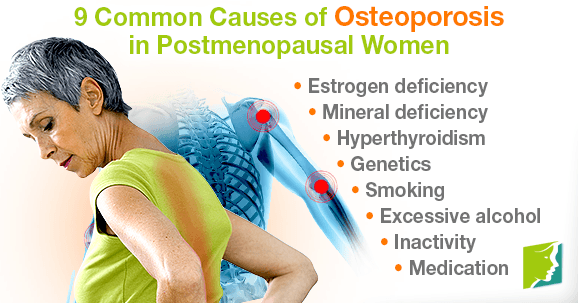Osteoporosis is a very common condition among postmenopausal women. This bone disease can develop over time for many different reasons and can be a painful experience. This is because your bones lose density and become weaker, which can cause frequent fractures from even the slightest impact.
It's important to be aware of the causes of this condition because there are usually no visible signs of having it. The bones do not change in outward appearance, the first signal is typically a fracture. Knowing these can help you determine if you're at risk
Estrogen Deficiency
The majority of people affected by osteoporosis are menopausal or post-menopausal women. This is because their estrogen levels dramatically reduce. This causes a rapid decrease in bone density. This is why it's very important to identify hormonal imbalance to help prevent and treat osteoporosis.
Mineral Deficiency
You probably already know that calcium is essential for strong bones. Getting this mineral is essential, but equally essential (yet less noted) is magnesium. Without magnesium, calcium cannot be absorbed in the body, instead it will be released through your urinary tract.
Vitamin Deficiency
Vitamin D and vitamin K are also essential for proper absorption of calcium in the body. You can eat all the calcium-dense foods you want but with D and K, again, it will not be retained in the body. In general these vitamins are also great for the building and maintaining of your bones. Read more about vitamins and supplements for osteoporosis.
Hyperthyroidism
Hyperthyroidism is common among menopausal women and is when your thyroid produces too many hormones. The high levels, over time, can weaken the bones.
Genetics
If you have a family history of osteoporosis it can increase your risk for the disease. Make sure to find out if you have family history of this condition and respond accordingly.
Smoking
Studies on smokers have shown that they have weaker bones and a higher likelihood of fracture. The toxins in the cigarette block the proper function of estrogen, calcium, and vitamin D in the body.
Excessive Alcohol
Alcohol can disrupt healthy building of the bones and speed up calcium loss. You are also more likely to take a fall when you are drunk, which can lead to fracture.
Inactivity
When you lead a sedentary lifestyle, your bones will weaken. The less you use your bones, and sit around doing nothing, the less strong you will be. It is important to try bone strengthening exercises to avoid this disease. Try incorporating 3 hours of low-impact exercise to your week for best results.
Medication
Many prescription medications can cause bone loss. Make sure to thoroughly check the labels of your medications to make sure this is not a side effect. You can also do additional research online, or ask your doctor.
More Information
Osteoporosis can really get in the way of your ability to freely move through your days. Simple activities like jogging or even dancing become risky, because your bones can become so brittle when you do not address the issue. The great thing is that your strength can be built back up with some positive lifestyle changes. Navigate below to learn everything about osteoporosis and the different ways to prevent and treat it.
Sources
- University of Maryland Medical Center. (2012). Osteoporosis. Retrieved March 27, 2014, from http://umm.edu/health/medical/reports/articles/osteoporosis


